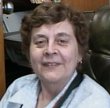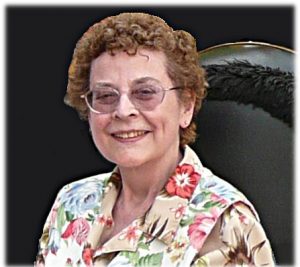People

Theresa Vaughan
Professor Emerita
Starting year at UNCG: 1973
Ending year at UNCG: 2008
Education
Degree(s): Ph.D. in Mathematics, Duke University
Research
Former Students: Charles Renn (M.A.)
Selected Publications
- with L. Carlitz, and Richard Scoville, Enumeration of permutations and sequences with restrictions, Duke Math. J. 40 (1973), 723–741.
- with L. Carlitz, and Richard Scoville, Some arithmetic functions related to Fibonacci numbers, Fibonacci Quart. 11 (1973), no. 4, 337–386.
- with J. V. Brawley, and L. Carlitz, Linear permutation polynomials with coefficients in a subfield, Collection of articles dedicated to Carl Ludwig Siegel on the occasion of his seventy-fifth birthday, II. Acta Arith. 24 (1973), 193–199.
- with L. Carlitz, Enumeration of sequences of given specification according to rises, falls and maxima, Discrete Math. 8 (1974), 147–167.
- Polynomials and linear transformations over finite fields, J. Reine Angew. Math. 267 (1974), 179–206.
- Linear transformations of a finite field. Linear Algebra and Appl. 8 (1974), 413–426. 20H20
with L. Carlitz, and Richard Scoville, Enumeration of pairs of permutations and sequences, Bull. Amer. Math. Soc. 80 (1974), 881–884. - with Andrew F. Long, Factorization of Q(h(T)(x)) over a finite field, where Q(x) is irreducible and h(T)(x) is linear. II, Linear Algebra and Appl. 11 (1975), 53–72.
- with L. Carlitz, and Richard Scoville, Enumeration of pairs of permutations, Discrete Math. 14 (1976), no. 3, 215–239.
- with Andrew F. Long, Factorization of Q(h(T)(x)) over a finite field where Q(x) is irreducible and h(T)(x) is linear. I, Linear Algebra and Appl. 13 (1976), no. 3, 207–221.
- A note on some arithmetic functions connected with the Fibonacci numbers, Fibonacci Quart. 14 (1976), no. 3, 244–248.
- with L. Carlitz, and Richard Scoville, Enumeration of pairs of sequences by rises, falls and levels, Manuscripta Math. 19 (1976), no. 3, 211–243.
- A note on the Jacobi-Perron algorithm, Pacific J. Math. 72 (1977), no. 1, 261–271.
- A generalization of the simple continued fraction algorithm, Math. Comp. 32 (1978), no. 142, 537–558.
- with K. A. Byrd, Counting and constructing orthogonal circulants, J. Combinatorial Theory Ser. A 24 (1978), no. 1, 34–49.
- with Ken Byrd, A group of integral points in a matrix parallelepiped, Linear Algebra Appl. 30 (1980), 155–166.
- The discriminant of a quadratic extension of an algebraic field, Math. Comp. 40 (1983), no. 162, 685–707.
- Corrigenda: The discriminant of a quadratic extension of an algebraic field, Math. Comp. 40 (1983), no. 162, 685–707. Math. Comp. 43 (1984), no. 168, 621.
- The construction of unramified abelian cubic extensions of a quadratic field, Acta Arith. 44 (1984), no. 4, 379–387.
- The construction of unramified cyclic quartic extensions of Q(sqrt m), Math. Comp. 45 (1985), no. 171, 233–242.
- On computing the discriminant of an algebraic number field, Math. Comp. 45 (1985), no. 172, 569–584.
- with Gary L. Mullen Cycles of linear permutations over a finite field, Linear Algebra Appl. 108 (1988), 63–82.
- with Paul Duvall, Pell polynomials and a conjecture of Mahon and Horadam, Fibonacci Quart. 26 (1988), no. 4, 344–353.
- with Paul Duvall Recursions for Carlitz triples, Fibonacci Quart. 27 (1989), no. 2, 131–138.
- with Frederick J. Portier; Whitney numbers of the second kind for the star poset, European J. Combin. 11 (1990), no. 3, 277–288.
- with Bruce Landman and Frederick J. Portier, Concavity properties of numbers of solutions of Diophantine equations, J. Combin. Math. Combin. Comput. 8 (1990), 39–49.
- Bounds for the rank of a permutation on a tree, J. Combin. Math. Combin. Comput. 10 (1991), 65–81.
- The normal closure of a quadratic extension of a cyclic quartic field, Canad. J. Math. 43 (1991), no. 5, 1086–1097.
- Constructing quaternionic fields, Glasgow Math. J. 34 (1992), no. 1, 43–54.
- with Bruce Landman and Frederick J. Portier Concavity properties of numbers satisfying the binomial recurrence, J. Combin. Math. Combin. Comput. 12 (1992), 23–32.
- Frederick J. Portier An algorithm for the factorization of permutations on a tree, J. Combin. Math. Combin. Comput. 18 (1995), 11–31.
- A permutation associated with GF(2n), J. Combin. Math. Combin. Comput. 21 (1996), 193–205.
with Robert T. Johnson; On union-closed families. I, J. Combin. Theory Ser. A 84 (1998), no. 2, 242–249. - with Robert T. Johnson; On union-closed families. I (sic), J. Combin. Theory Ser. A 85 (1999), no. 1, 112–119.
- Factoring a permutation on a broom, J. Combin. Math. Combin. Comput. 30 (1999), 129–148.
- with Ezra Brown; Cycles of directed graphs defined by matrix multiplication (mod n), Discrete Math. 239 (2001), no. 1-3, 109–120.
- Families implying the Frankl conjecture, European J. Combin. 23 (2002), no. 7, 851–860.
- A note on the union-closed sets conjecture, J. Combin. Math. Combin. Comput. 45 (2003), 95–108.
- with Ezra Brown; Configurations with subset restrictions, J. Combin. Math. Combin. Comput. 48 (2004), 197–215.
- Three-sets in a union-closed family, J. Combin. Math. Combin. Comput. 49 (2004), 73–84.
Brief Biography
Theresa Elizabeth Phillips Vaughan, 67, died June 13, 2009 at Moses Cone Hospital after a very brief illness. A memorial service was held at Forbis & Dick Funeral Home 5926 W. Friendly Avenue, Thursday June 18 2009 at 7 PM with visitation immediately following the service.
Theresa was born in Kearney Nebraska, and grew up in California. She received a B.A. from Antioch College, an M.A. from American University, and a Ph. D. from Duke University all in mathematics. Professor Theresa Vaughan was a member of the Mathematics Faculty at UNCG for 21 years before retiring in 2008. She was very involved with her students, and served as chair of the Mathematics Scholarship committee. She was vice president of the Board of Directors of the International Fibonacci Association, and a member of several professional organizations. Most of her research was in algebra, finite fields, combinatorics and discrete mathematics. She was preceded in death by her mother, Jean Bostrom Phillips, a sister, Julia Redant, and a brother Randall. She is survived by her husband, Professor Jerry Vaughan, her father, Randall Phillips, and two sisters, Mary Kantor and Jeanette Irving.
In 1988, Theresa conceived the idea of a one-day regional conference on number theory and combinatorics, and she hosted the first of what grew into an annual two-day conference called SERMON which is an acronym the “SouthEastern Regional Meeting On Numbers.” SERMON has met every year from 1988 until the present (2009) at the following schools: UNC Greensboro, University of Georgia, University of South Carolina, The Citadel, College of Charleston, Wake Forest University, and Clemson University. More information may be available at http://www.math.clemson.edu/~kevja/SERMON/
 2008
2008





